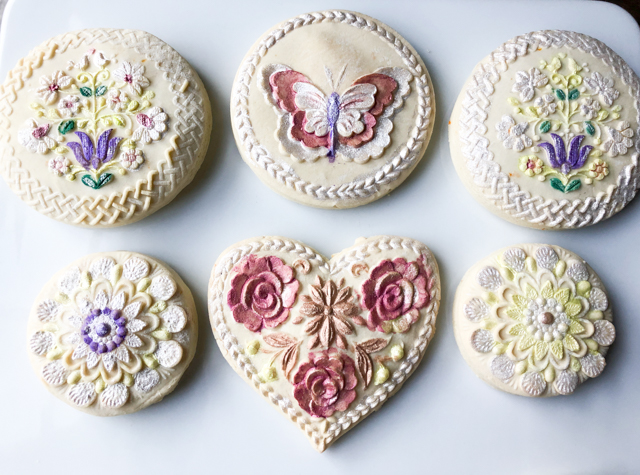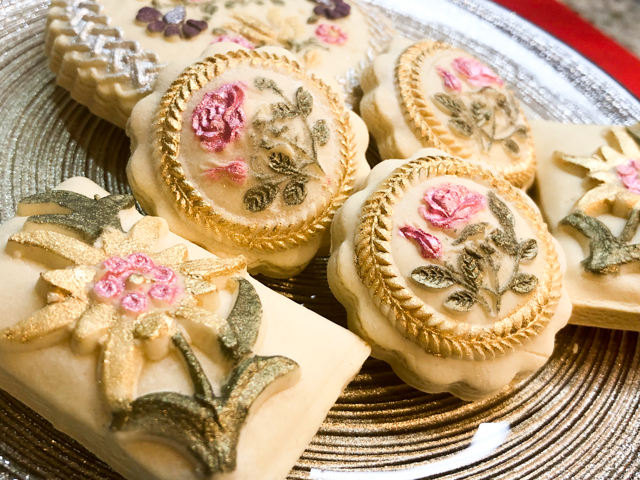Springerle cookies have been around for more than 700 years, and just that thought brings me a smile. It fascinates me that after hundreds of years we still talk about them and so many bakers – particularly in Europe – preserve the tradition by baking batches and batches during the holiday season. The name translates from German as “little jumpers”. Some say that indicates the way they seem to jump in the oven when they bake. Others believe that in the beginning the images imprinted on the cookies showed men on horses, like little jumpers. We’ll probably never know for sure, but what we do know is that they are flavored with anise, leavened with a special ingredient (ammonium carbonate, aka Hartshorn), and the dough takes a large amount of eggs beaten for a long time. Back in the 1300’s, a baker not only had to make the cookies, but also carve the wooden molds they were shaped in. The reputation of a baker would rest not only on the cookies themselves, but in the complexity and beauty of the mold he had produced. Absolutely amazing. Disclaimer: I did not carve my own molds. Please don’t judge.
SPRINGERLE COOKIES
(scaled down from House on the Hill)
1/4 teaspoon baker’s ammonia (Hartshorn)
1 tablespoons milk
3 large eggs, room temperature
360g powdered sugar
57g (1/4 cup) unsalted butter, softened but not melted
1/4 teaspoon salt
1/4 teaspoon of anise oil
454g sifted cake flour (I used Softasilk)
grated rind of orange
to paint the cookies (optional):
powder luster (mine are from Oh Sweet Art)
vodka or lemon extract
Make the cookies: Dissolve baker’s ammonia in milk and set aside (avoid the temptation to take a sniff, you will regret it). Beat eggs until very thick, this will take from 10 to 15 minutes. Slowly beat in the powdered sugar, then the softened butter. Add the the mixture of baker’s ammonia and milk, salt, anise oil and orange zest.
Gradually beat in as much flour as you can with the mixer, then stir in the remainder of the flour to make a stiff dough. Turn onto floured surface and knead in enough flour to make a good print without sticking. Refrigerate for one hour, but keep in mind the dough can be refrigerate the dough for up to 3 days.
On a floured surface, roll dough depending on the depth of the carving in the cookie press you are using. Shallow carvings will need to be thinner while deeper carvings will need to be thicker. Flour your cookie mold for each and every pressing. Press the mold firmly and straight down into the dough, then lift, cut with the cookie cutter of your choice, and place the formed cookie onto a flat surface to dry.
Do not cover the cookies while they dry. The goal of drying is to set the design. Let the cookies dry at least for 24 hours. It is better to leave them alone for a couple of days, so the design will be better retained during baking.
On baking day, heat the oven to 255F to 325F (depending on the size of your cookie and how white you like to have them), for 10 to 15 minutes. Let the cookies cool and paint, if you so desire.
ENJOY!
to print the recipe, click here
Comments: I cannot lie to you, Springerle baking can be tricky. I only do it in December, because it is so deeply associated with this time of the year. In fact, it is quickly becoming a personal holiday tradition for me. First thing to keep in mind, you need the special leavening agent. It has a crystal, grainy structure and gives the cookie its unique texture. If you bake them with regular baking powder, you lose that component. Second, be patient. These cookies cannot be baked on the same day you shape them because the pattern needs to set by drying, sometimes it can take 3 days, depending on your environment. I never had to wait more than 48 hours.

If they are not dry, when they go into the oven, the pattern will be quickly lost as the cookie expands. If they are fully dry but the oven a little too hot, they will form cracks and might even explode, like you can see on my first composite photo above. That brings me to my third advice: always, always, ALWAYS bake a test cookie. I normally place three, one large, one medium, one small, and see how they behave. The temperature that works best for me (for all cookie sizes, in fact) is 275F. It might be different for your oven.

Painting them is the part I enjoy the most. It is a good idea to get very fine brushes so that you can highlight details. I think pastel tones, silver, white and gold are my favorites, particularly to decorate more classic designs.
But this year I pushed the boundaries a bit and used more dramatic colors in some of my cookies…
I also used more modern shapes, that would quite likely horrify bakers from old Swabia…
These were bought from Fun Food Tools (at etsy.com). They definitely take Springerle into a totally new direction… My apologies to the purists. Since they were already such a dramatic departure, I went crazy with the colors also…
As you know, the main flavor of these cookies is anise, which not everyone is fond of. For real anise lovers, you can go one step further and bake them over a layer of anise seeds. I like the flavor, but don’t care for the texture of the seeds at the bottom, so I always skip this step.
I hope you enjoyed this final post on Holiday Cookies. Springerle baking will definitely be part of my end of the year routine. As to the other 11 months, I will practice baking molded cookies using regular baking powder and different flavors. Stay tuned!
ONE YEAR AGO: Bread – Episode 2 of Great American Baking Show
TWO YEARS AGO: Apple and Sobacha Caramel Dome Cake
THREE YEARS AGO: Cocktail Spiced Nuts
FOUR YEARS AGO: How the Mighty Have Fallen
FIVE YEARS AGO: Festive Night at Central
SIX YEARS AGO: The Perfect Boiled Egg
SEVEN YEARS AGO: Light Rye Sourdough with Cumin and Orange
EIGHT YEARS AGO: Homemade Calziones
NINE YEARS AGO: Plum-Glazed Duck Breasts
TEN YEARS AGO: Holiday Double-Decker
ELEVEN YEARS AGO: New York Deli Rye








WOW. These are too beautiful to eat!
LikeLiked by 1 person
thank you!
LikeLike
You have way too much time on your hands. Just jealous!! Happy Holidays!
LikeLiked by 1 person
Happy Holidays for you too….
LikeLike
Your posts are so enjoyable, instructive, friendly, useful and just plain fun to read. Even if there is something that you bake a lot and I never have intentions of making (that’s you, macarons, which just don’t taste good enough to me to bother with, no matter how many people like macarons,) I learn from your baking experience.
LikeLiked by 1 person
thank you so much! your comment is the kind of stuff that gives me energy to go on blogging…. SERIOUSLY! gave me a smile that just won’t go away….
LikeLike
I may not be a baker. I may but rarely eat an offering such as this tho’ I have known about springerle since childhood. Yours are absolutely beautiful . . . it is a joy to read your post . . . hugs . . .
LikeLiked by 1 person
loved making them, we had (PHil and I) one cookie each, and the rest was spread around friends 😉
LikeLiked by 1 person
Such beautiful cookies. I am not fond of anise. Would lemon flavor work as well?
LikeLike
yes, lemon or orange, or even a combination of both
LikeLike
Way too pretty!!
LikeLiked by 1 person
thank you! it is almost therapeutic to just sit and paint…. love it!
LikeLike
Beautiful!
LikeLike
I have been baking Springerle cookies for three years. I really love my molds and painting the cookies. I’ve enjoyed your blog so much and have learned so many helpful hints. I’ve incorporated them in my baking and see a real difference. Thanks so much for sharing your knowledge.
LikeLike
Linda, you gave me a smile that won’t go away until the end of 2021!!!!! Thank you so much!
LikeLike